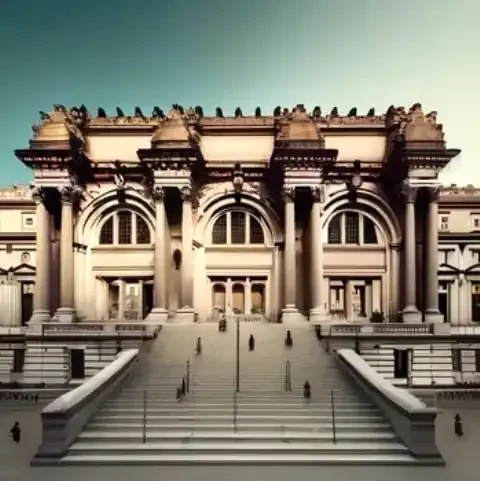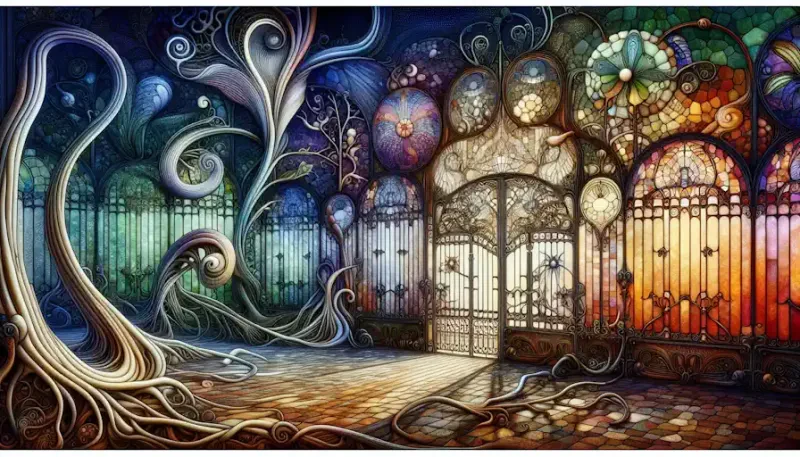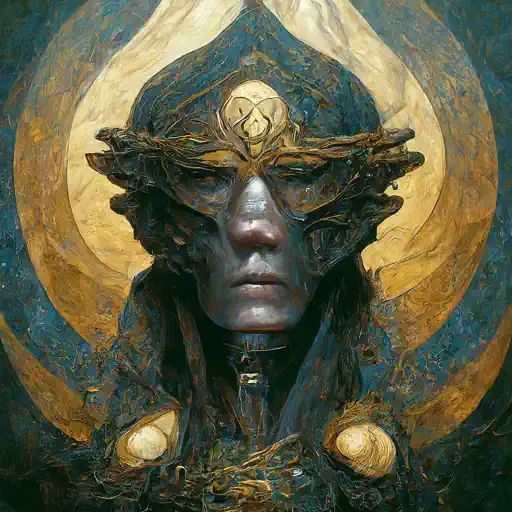Introduction
Nestled amidst the vibrant streets of New York City, The Metropolitan Museum of Art, fondly known as The Met, emerges as an emblem of cultural eminence and artistic splendor. Its illustrious history, spanning over a century, traces back to the fervent aspirations of a group of visionary leaders who sought to establish a museum that would rival the great cultural institutions of Europe. Founded in 1870, The Met has since evolved into a beacon of artistic enlightenment, attracting millions of visitors annually with its extensive collections, architectural magnificence, and transformative experiences. Its founding represented a pivotal moment in America's cultural landscape, reflecting the nation's burgeoning wealth, cosmopolitan aspirations, and burgeoning interest in art and culture.
The Met's establishment was not merely an exercise in cultural emulation but a bold declaration of American ingenuity and ambition. As the United States sought to assert its cultural identity on the world stage, The Met emerged as a tangible manifestation of the nation's artistic aspirations, showcasing the breadth and depth of human creativity from antiquity to the present day. Its founders envisioned a museum that would serve as a cultural nexus, bringing together art and education under one roof and fostering a deeper appreciation for the arts among the American public.
Over the decades, The Met has grown from humble beginnings into a sprawling complex of galleries, wings, and gardens, each bearing witness to the museum's evolution and expansion. From its iconic main building on Fifth Avenue to its satellite locations at the Cloisters and the Met Breuer, The Met's architectural ensemble reflects the eclectic tapestry of New York City's architectural heritage, spanning centuries of artistic expression and innovation.
Today, The Met stands as a testament to the enduring power of art to inspire, educate, and transform lives. Its collections encompass a vast array of artistic traditions and cultural heritage from around the world, offering visitors a panoramic view of human creativity across time and space. From ancient artifacts to contemporary masterpieces, each artwork tells a story, inviting viewers to engage with the past, present, and future in meaningful and profound ways.
As we embark on this journey through The Met's storied history, architectural splendor, diverse collections, educational initiatives, community outreach endeavors, conservation efforts, and visitor experiences, we invite you to immerse yourself in the richness and diversity of the world of art and culture. Whether you are a seasoned art aficionado or a curious novice, The Met offers something for everyone, promising an unforgettable experience that will leave a lasting impression for years to come. Join us as we explore the boundless wonders of The Metropolitan Museum of Art and discover the transformative power of art to inspire, enlighten, and uplift humanity.
History and Evolution
Origins and Founding Vision
The roots of The Metropolitan Museum of Art lie in the fertile soil of 19th-century America, a period marked by rapid industrialization, urbanization, and cultural renaissance. In the midst of this dynamic era, a group of visionary leaders, captivated by the cultural riches of Europe and inspired by the democratic ideals of the young nation, conceived the audacious idea of establishing a museum that would rival the great institutions of the Old World. Their vision was not simply to import European culture but to cultivate an American cultural identity rooted in the ideals of freedom, innovation, and inclusivity.
The seeds of The Met were sown in 1866, when a group of like-minded individuals convened at the Union League Club in New York City to discuss the formation of a museum that would bring art and education to the masses. Led by luminaries such as John Taylor Johnston, William Cullen Bryant, and Joseph Choate, the group articulated a bold vision for the museum as a beacon of enlightenment and cultural enrichment, serving as a sanctuary for the cultivation of aesthetic sensibility and intellectual curiosity.
In 1870, their vision materialized with the incorporation of The Metropolitan Museum of Art by an act of the New York State Legislature. The museum's charter outlined its mission to collect, preserve, study, and exhibit works of art that would "illustrate the progress and development of art," reflecting the founders' commitment to fostering a deeper understanding and appreciation of the visual arts among the American public. With its founding, The Met embarked on a transformative journey that would shape the cultural landscape of New York City and the nation at large.
Growth and Expansion
From its modest beginnings in a rented space at 681 Fifth Avenue, The Met quickly outgrew its confines as its collections grew in size and scope. In 1872, the museum acquired its first permanent home at 128 West 14th Street, followed by a move to a larger location at 681 Fifth Avenue in 1873. However, even these spaces proved insufficient to accommodate the museum's burgeoning collections and ambitious aspirations.
In 1878, The Met's Board of Trustees embarked on a bold plan to construct a purpose-built museum that would rival the grand institutions of Europe. They commissioned architects Calvert Vaux and Jacob Wrey Mould to design the museum's iconic main building on Fifth Avenue and 82nd Street, a Beaux-Arts masterpiece that would serve as a fitting monument to the nation's cultural aspirations. The building, inspired by classical precedents such as the Louvre and the British Museum, featured a monumental facade adorned with Corinthian columns, a grand central staircase, and a soaring dome that would become an iconic symbol of the museum.
The main building opened its doors to the public in 1880, ushering in a new era of artistic enlightenment and cultural enrichment in New York City. Over the ensuing decades, The Met continued to expand its physical footprint with the construction of new wings, galleries, and annexes, including the American Wing, the Cloisters, and the Met Breuer, each adding to the museum's architectural legacy and cultural significance.
Milestones and Legacy
Throughout its storied history, The Met has celebrated numerous milestones and achievements that have shaped its enduring legacy as a cultural institution of international renown. From landmark acquisitions and exhibitions to groundbreaking research and educational initiatives, each milestone has contributed to The Met's reputation as a custodian of human creativity and cultural heritage.
One of the museum's most significant milestones was the establishment of the Cloisters museum and gardens in 1938, dedicated to the art and architecture of medieval Europe. Housed in a meticulously reconstructed medieval monastery in Fort Tryon Park, the Cloisters offered visitors a glimpse into the rich artistic and cultural heritage of the Middle Ages, further enriching The Met's diverse collections and expanding its educational offerings.
In more recent years, The Met has continued to innovate and evolve, embracing new technologies and engaging with diverse audiences in innovative ways. The museum's digital initiatives, including online collections, virtual tours, and interactive experiences, have extended its reach far beyond its physical walls, making its cultural treasures accessible to audiences around the world. Meanwhile, its commitment to diversity, equity, and inclusion has led to the development of programs and initiatives aimed at engaging underserved communities and amplifying diverse voices within the museum and beyond.
As The Met looks to the future, its legacy as a global cultural institution remains as vibrant and relevant as ever, a testament to the enduring power of art to inspire, educate, and unite humanity across time and space. Through its collections, exhibitions, educational programs, and community outreach efforts, The Met continues to fulfill its founding mission of bringing art and culture to the masses, ensuring that its legacy will endure for generations to come.
Architectural Splendor
Architectural Design and Significance
The Metropolitan Museum of Art stands as a testament to the evolution of architectural styles and tastes over the centuries. Its iconic main building, situated majestically along Fifth Avenue, exudes an air of grandeur and sophistication, captivating visitors with its monumental proportions and classical elegance. Designed by architects Calvert Vaux and Jacob Wrey Mould in the Beaux-Arts style, the main building is a masterpiece of architectural design, blending classical elements with modern innovation to create a timeless masterpiece.
At the heart of the main building is the Great Hall, a grand entrance hall adorned with soaring ceilings, sweeping staircases, and majestic chandeliers. Inspired by the grandeur of European palaces, the Great Hall serves as the museum's central gathering space, welcoming visitors into its vast expanse with a sense of awe and wonder. From the Great Hall, visitors can explore a labyrinth of galleries and wings, each offering a unique journey through the history of art and culture.
The main building's facade is equally impressive, featuring a symmetrical arrangement of Corinthian columns, elaborate carvings, and decorative embellishments. Inspired by classical architecture, the facade evokes the grandeur of ancient temples and monuments, serving as a fitting backdrop for the museum's vast collections and artistic treasures.
In addition to its main building, The Met boasts a diverse array of architectural features and hidden gems waiting to be discovered by visitors. From the serene beauty of the Astor Chinese Garden Court to the majestic splendor of the Temple of Dendur, each space offers a unique glimpse into the rich tapestry of human creativity and ingenuity.
Iconic Features and Hidden Gems
Within the hallowed halls of The Met lie a myriad of iconic features and hidden gems waiting to be discovered by visitors. The Temple of Dendur, a gift from the Egyptian government, stands as a testament to the enduring legacy of ancient civilizations, with its majestic columns, intricate hieroglyphics, and serene reflecting pool transporting visitors back in time to the banks of the Nile.
Elsewhere in the museum, the Astor Chinese Garden Court offers a tranquil oasis amidst the hustle and bustle of the city, with its serene pond, lush foliage, and traditional Chinese architecture providing a peaceful retreat for contemplation and reflection. Meanwhile, the American Wing showcases the nation's rich artistic heritage, with galleries dedicated to American painting, sculpture, and decorative arts from the colonial period to the present day.
Behind the scenes, hidden gems await discovery, from conservation laboratories and storage facilities to staff offices and research centers, where the meticulous care and preservation of The Met's vast collections come to life. Here, visitors can catch a glimpse of the painstaking work that goes into conserving and protecting the museum's treasures for future generations to enjoy.
Preservation Efforts and Sustainability
Preserving The Met's architectural treasures is a paramount priority that requires careful planning, rigorous maintenance, and sustainable practices. The museum employs a range of innovative technologies and conservation methods to protect its buildings and grounds from the ravages of time and environmental degradation.
From climate-controlled environments and humidity monitoring systems to energy-efficient lighting and sustainable materials, The Met is committed to minimizing its ecological footprint while safeguarding its architectural heritage for future generations to enjoy. Through careful stewardship and responsible management, The Met ensures that its architectural treasures will continue to inspire and delight visitors for centuries to come.
Collections and Exhibitions
Permanent Collections: A Panorama of Human Creativity
At the heart of The Metropolitan Museum of Art lies its permanent collections, a vast and diverse array of artistic treasures spanning over 5,000 years of human history and encompassing a multitude of cultures and civilizations from around the globe. From ancient artifacts to contemporary masterpieces, each gallery offers visitors a curated journey through the richness and diversity of human creativity, inviting them to explore the beauty, complexity, and interconnectedness of the world's artistic traditions.
The museum's collections are organized into various departments, each dedicated to a specific period, region, or artistic medium. The European Paintings department boasts an impressive array of masterpieces by renowned artists such as Rembrandt, Vermeer, and Van Gogh, offering visitors a glimpse into the evolution of European art from the Renaissance to the modern era. The Greek and Roman Art department features a rich collection of sculptures, pottery, and decorative arts from ancient Greece and Rome, while the Asian Art department showcases the artistic achievements of cultures from across Asia, including China, Japan, India, and Korea.
Other highlights of The Met's permanent collections include the Egyptian Art department, home to one of the most comprehensive collections of ancient Egyptian artifacts outside of Egypt, and the Islamic Art department, which features a diverse array of art and artifacts from the Islamic world, including ceramics, textiles, and manuscripts. Meanwhile, the Modern and Contemporary Art department offers visitors a glimpse into the vibrant world of 20th and 21st-century art, with works by iconic artists such as Picasso, Warhol, and Pollock challenging and inspiring viewers with their innovative approaches to form, color, and expression.
Special Exhibitions: Exploring New Horizons
In addition to its permanent collections, The Met hosts a dynamic array of special exhibitions throughout the year, offering visitors the opportunity to engage with new and provocative works of art, explore emerging trends and themes in the world of contemporary art, and delve deeper into specific periods, styles, or artistic movements. These exhibitions, often curated around a central theme or concept, provide a platform for experimentation, innovation, and dialogue, inviting visitors to think critically and creatively about the role of art in society and the world around them.
Recent exhibitions at The Met have explored a wide range of topics, from the intersection of art and technology to the relationship between art and social justice. For example, the museum's 2019 exhibition "Camp: Notes on Fashion" examined the concept of "camp" in fashion and art, exploring its origins, evolution, and significance in popular culture. Meanwhile, the 2020 exhibition "Making The Met, 1870-2020" celebrated the museum's 150th anniversary by showcasing highlights from its vast collection and tracing its evolution over the past century and a half.
In addition to its main exhibitions, The Met also hosts a variety of smaller, focused exhibitions throughout the year, highlighting specific artists, movements, or genres within the museum's collections. These exhibitions offer visitors the opportunity to delve deeper into particular areas of interest, discover new artists or perspectives, and engage with art in new and unexpected ways.
Overall, The Met's special exhibitions play a crucial role in the museum's mission to inspire, educate, and engage audiences of all ages and backgrounds, fostering a deeper appreciation for the arts and enriching the cultural life of New York City and beyond. Whether exploring the museum's permanent collections or attending one of its temporary exhibitions, visitors are sure to find something to ignite their imagination and spark their curiosity at The Metropolitan Museum of Art.
Educational Programs and Outreach
Lifelong Learning: Engaging Audiences of All Ages
The Metropolitan Museum of Art is dedicated to providing educational opportunities for audiences of all ages and backgrounds, fostering a lifelong passion for learning, creativity, and cultural enrichment. Through a diverse array of programs and initiatives, the museum seeks to engage visitors in meaningful and transformative experiences that deepen their understanding and appreciation of the arts.
For children and families, The Met offers a wide range of educational programs designed to inspire curiosity, spark creativity, and instill a love of art from an early age. Family programs, such as art-making workshops, gallery tours, and storytelling sessions, provide opportunities for parents and children to explore the museum's collections together, fostering a sense of connection and shared discovery. Additionally, programs such as the MetKids website and the MetFamilies app offer interactive resources and activities that encourage children to explore art and culture in fun and engaging ways.
For adults, The Met offers a diverse array of educational opportunities designed to deepen their understanding of art history, theory, and practice. From lectures and symposia to adult education courses and workshops, the museum provides a platform for lifelong learners to engage with art in a meaningful and intellectually stimulating way. Whether delving into the masterpieces of the Renaissance, exploring the complexities of contemporary art, or learning about the cultural heritage of ancient civilizations, adult learners can find a wealth of opportunities to expand their knowledge and enrich their cultural horizons at The Met.
Community Engagement: Building Bridges Beyond the Museum Walls
Community engagement lies at the heart of The Met's mission, extending the museum's reach beyond its physical walls and fostering connections and dialogue among diverse communities both locally and globally. Through a variety of outreach initiatives and collaborative partnerships, The Met seeks to bring the transformative power of art and education to underserved communities and diverse audiences, ensuring that its collections and resources are accessible to all.
One such initiative is the Met in the Community program, which brings art-making workshops, performances, and educational resources to community centers, schools, and libraries throughout New York City. Through this program, The Met seeks to inspire creativity, foster cultural understanding, and promote social inclusion by providing access to the museum's collections and expertise to communities that may not otherwise have the opportunity to visit the museum in person.
Additionally, The Met's global outreach efforts aim to connect with audiences around the world through collaborative partnerships, cultural exchange programs, and digital initiatives. Through initiatives such as the MetAround program, which brings exhibitions and educational resources to partner institutions around the world, The Met seeks to foster cross-cultural dialogue, promote mutual understanding, and celebrate the diversity of human creativity and expression.
Overall, The Met's educational programs and community outreach initiatives play a crucial role in fulfilling the museum's mission to inspire, educate, and enrich the lives of people of all ages and backgrounds. By engaging with diverse audiences in innovative and meaningful ways, The Met seeks to foster a deeper appreciation for the arts and strengthen the bonds that unite us as a global community.
Conservation and Preservation
Guardians of Cultural Heritage: Preserving the Past for Future Generations
Conservation and preservation are at the heart of The Metropolitan Museum of Art's mission, ensuring the integrity and longevity of its vast collections for the benefit of future generations. The museum's conservation department, comprising skilled conservators, scientists, and technicians, works tirelessly to safeguard the cultural treasures entrusted to its care from the effects of time, environmental factors, and human intervention.
Using a combination of cutting-edge techniques and time-honored methods, The Met's conservation team meticulously examines, analyzes, and treats each artwork with the utmost care and precision. Whether it's a delicate textile, a fragile ceramic, or a monumental sculpture, every object in the museum's collections undergoes a rigorous conservation process tailored to its unique materials, condition, and historical significance.
The conservation process begins with a comprehensive examination and assessment of the artwork's condition, using a variety of scientific tools and imaging techniques to identify any damage, deterioration, or alterations. This information informs the development of a customized conservation treatment plan, which may include cleaning, repair, stabilization, and preventive measures to mitigate future deterioration.
Throughout the conservation process, conservators work closely with curators, scholars, and other museum professionals to ensure that the artwork's original integrity and historical context are preserved. This collaborative approach allows conservators to make informed decisions about the best course of action for each object, taking into account its artistic, cultural, and historical significance.
In addition to treating individual artworks, The Met's conservation department is also engaged in ongoing research and scholarship aimed at advancing the field of conservation science and practice. Through collaborative projects, interdisciplinary research, and knowledge-sharing initiatives, The Met contributes to the broader understanding of cultural heritage conservation and helps to develop new techniques and methodologies for preserving the world's artistic treasures.
Technological Innovations and Best Practices
In its ongoing quest to preserve and protect its collections, The Metropolitan Museum of Art employs a range of innovative technologies and best practices that reflect the latest advancements in the field of conservation science. From state-of-the-art imaging techniques and environmental monitoring systems to advanced materials analysis and non-invasive treatments, the museum's conservation department utilizes a diverse toolkit of scientific methods and technologies to ensure the long-term stability and preservation of its collections.
One such innovation is the use of multispectral imaging, a technique that employs various wavelengths of light to reveal hidden details and features in artworks that may not be visible to the naked eye. By capturing images at different wavelengths, conservators can uncover underlying layers, detect changes over time, and identify areas of deterioration or damage that require attention.
Another area of technological innovation is the development of climate control systems and environmental monitoring devices that help to maintain stable temperature and humidity levels within the museum's galleries and storage areas. These systems play a crucial role in preventing damage from fluctuations in environmental conditions, such as temperature extremes, high humidity, or fluctuations in light exposure.
In addition to technological innovations, The Met's conservation department also adheres to a set of best practices and ethical guidelines that govern its conservation activities. These guidelines, established by professional organizations such as the American Institute for Conservation (AIC) and the International Council of Museums (ICOM), ensure that conservation treatments are carried out with the highest standards of care, integrity, and respect for the artwork's original materials and intent.
Overall, The Met's commitment to conservation and preservation reflects its dedication to safeguarding the world's cultural heritage for future generations and ensuring that its collections remain accessible and inspiring for years to come. Through a combination of scientific expertise, technological innovation, and ethical stewardship, The Met continues to serve as a global leader in the field of cultural heritage conservation, advancing the understanding and appreciation of art and culture for audiences around the world.
Visitor Experience and Accessibility
Enhancing the Visitor Experience: Navigating the Vastness of The Met
Navigating the vastness of The Metropolitan Museum of Art can be an awe-inspiring but overwhelming experience for visitors, given the sheer size and diversity of its collections. To enhance the visitor experience and ensure that everyone can make the most of their time at the museum, The Met offers a range of resources and amenities designed to help visitors navigate its galleries, engage with its collections, and enjoy a memorable and enriching visit.
One of the most valuable resources available to visitors is the museum's audio guide, which provides informative and engaging commentary on select artworks and galleries throughout the museum. Available in multiple languages, the audio guide allows visitors to explore the museum at their own pace, offering insights and context that deepen their understanding and appreciation of the art on display.
In addition to the audio guide, The Met offers a variety of guided tours and programs led by knowledgeable educators and docents, who provide expert insights into the museum's collections, history, and architecture. Whether it's a thematic tour focused on a specific period or genre of art, a highlights tour showcasing the museum's most iconic works, or a special tour designed for families or school groups, there are options available for visitors of all ages and interests.
For visitors with accessibility needs, The Met is committed to ensuring equitable access to its collections and facilities. The museum offers a range of services and accommodations, including wheelchair rentals, sign language interpretation, assistive listening devices, and tactile tours for visitors with visual impairments. Additionally, the museum's website provides detailed information on accessibility features, including barrier-free routes, accessible entrances, and parking options, to help visitors plan their visit in advance.
Digital Engagement and Virtual Access
In an increasingly digital age, The Metropolitan Museum of Art embraces technology to provide virtual access to its collections and exhibitions, offering online resources, virtual tours, and interactive experiences that extend the museum's reach beyond its physical walls. Through its website and mobile app, The Met offers virtual tours of select galleries and exhibitions, allowing visitors to explore the museum's collections from the comfort of their own homes.
In addition to virtual tours, The Met's website features a wealth of online resources, including digitized collections, educational videos, interactive timelines, and virtual exhibitions, that provide opportunities for learning and exploration for audiences of all ages. Whether it's a virtual tour of the Egyptian galleries, a behind-the-scenes look at conservation work, or an interactive lesson on art history, there are resources available to engage and inspire visitors from around the world.
The Met's digital engagement initiatives also extend to social media platforms, where the museum shares behind-the-scenes content, highlights from its collections, and updates on upcoming exhibitions and programs. Through platforms such as Facebook, Twitter, Instagram, and YouTube, The Met connects with audiences around the world, fostering dialogue, creativity, and engagement with art and culture in new and unexpected ways.
Overall, The Met's commitment to digital engagement and virtual access reflects its dedication to making its collections and resources accessible to audiences of all ages and backgrounds, regardless of geographical location or physical ability. By embracing technology and innovation, The Met ensures that its cultural riches are available to all, inspiring curiosity, creativity, and lifelong learning for generations to come.
Conclusion
As we conclude our immersive journey through The Metropolitan Museum of Art, we are left with a profound appreciation for its unparalleled legacy and enduring impact on the world of art and culture. From its humble beginnings in the 19th century to its current status as a global cultural institution, The Met has continually evolved and adapted to meet the changing needs and interests of its diverse audiences.
At the heart of The Met's success lies its unwavering commitment to excellence, accessibility, and inclusivity. Through its extensive collections, innovative exhibitions, educational programs, and community outreach efforts, the museum has inspired millions of visitors to explore the boundless wonders of human creativity and expression, fostering cross-cultural understanding, dialogue, and appreciation for the arts.
Looking to the future, The Met remains steadfast in its mission to inspire, educate, and enrich the lives of people of all ages and backgrounds, both within its walls and beyond. As we navigate the challenges and opportunities of the 21st century, let us celebrate The Met's enduring legacy as a beacon of artistic enlightenment and cultural enrichment, ensuring that its treasures continue to inspire and uplift humanity for generations to come.







